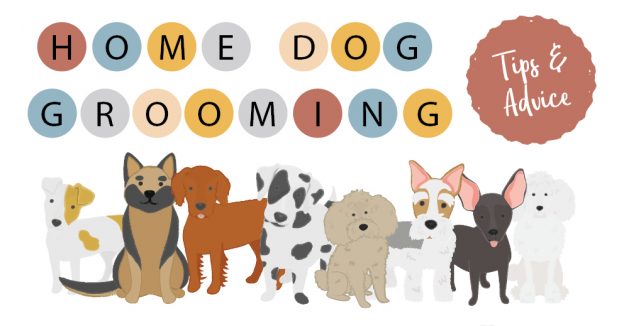As it has been impossible to visit the groomers over the past few months, and we’re only just beginning to adjust to the “new normal” as lockdown eases, grooming your dog may have fallen off your radar. You may even think that dog grooming isn’t that important—after all, his coat looks to be in okay shape, so why bother?
Grooming goes way beyond a quick swipe with a brush. Grooming is about looking after your whole dog – it’s skin, eyes, ears, nails, teeth, and yes, coat. Imagine if you put off washing and combing your hair for weeks or even months—yikes! Understandably, you’d feel grubby and uncomfortable…and it’s no different for your dog! If not groomed regularly, some dogs may also develop painful mats and skin problems or suffer from overgrown nails.
Grooming is an essential part of caring for your dog and by maintaining your dog’s coat in between visits to the groomers, you will ensure that the coat and skin is kept in good condition all year round.
Now more than ever is a great time to get clued-up on home dog grooming, because they’re woof it!
From scruffy schnauzers, to tangled Terries – check out our top tips and information we’ve put together about how to pamper your pooch at home and maintain those lockdown locks safely.
Understand your dog’s coat requirements
Home dog grooming begins by getting to know your dogs’ coat and skin by routinely checking it. This is really important, as a change in either can be the first time that you are aware that there could be an underlying health problem. Dog grooming treatments and techniques can also vary greatly depending on coat types. For example, you should be mindful that long-haired or double coated breeds require extensive maintenance. “Long hair don’t care” is not a good mantra for dogs with these coat types. Without regular brushing, these dogs can quickly develop painful mats on various parts of their bodies. Check out our visual gallery for more information on coat types:
[ngg src=”galleries” ids=”5″ display=”basic_imagebrowser”]Fun fact: Different dog breeds have different coat styles, and these usually stem from the jobs that dogs have done in the past. For instance a fox terrier will have protection around the muzzle and front of the face, as they were used to keep foxes at bay, this hair would protect their face.
Don’t over bathe your dog
Only give your dog a bath when it’s really needed, such as if they’ve gotten smelly or dirty during a muddy walk. Washing dogs’ coats strips them of their natural oils and can cause skin and temperature-regulating issues if overdone. What’s more, don’t used perfumed or scented human bath products, as these can irritate your dogs’ skin or nose, and always pat your dog dry with a soft towel rather than rubbing, in order to prevent tangles and matts.
Check your dog for ticks after walks
After taking your dog for a walk, it’s a good idea to check them for ticks. You can do this by moving your hands over their body to check for any unusual small bumps, particularly around their ears, head, neck, groin, armpits and feet. Ticks are big enough to spot and regular grooming helps to remove/discover them.
Generally, grooming regularly is a good opportunity to look out for parasites and irritants on your dog’s skin. Check our visual gallery to learn more about the kinds of parasites you should look for and how you can prevent and treat these conditions:
[ngg src=”galleries” ids=”6″ display=”basic_imagebrowser”]
Treat your dog with kindness and patience
It’s important to approach any home grooming with empathy. Go slowly and pay close attention to how your dog reacts to what you’re doing. If you spot signs of stress such as trembling, whining, or panting that’s not heat-related, you should take a break if needed. Be sure to make the grooming process a positive experience by giving lots of praise, petting, cuddles and treats. If you treat your dog with kindness and patience, your dog will eventually feel more comfortable with grooming at home.
Choose a reputable, qualified dog groomer
If your dog gets something stuck in its fur that you cannot brush out, you may feel confident enough to snip it out. However, be mindful that many dogs have been injured from amateur groomers making mistakes. It’s important to maintain regular visits to the groomers where possible, and leave expert clipping and cutting to a professional, qualified dog groomer.
As a responsible dog owner, it’s crucial to choose a groomer who is professionally qualified to carry out the care of your loved companion. Look for dog groomers who have undertaken a recognised course. This shows that they have learnt about different grooming techniques, different types of equipment, and how to use it safely. Qualified Groomers will have learned about parasites, and other diseases and disorders that can affect the health, and coat and skin. They will also have learned to look at body language, and how to handle dogs in their care with consideration and kindness.
The College of Animal Welfare runs three commercial grooming parlours; CAW Grooming School Huntingdon (Cambridgeshire), CAW Grooming School Wigan and Campus Vets and Pets in Leeds (West Yorkshire). We pride ourselves on offering a professional and friendly service at affordable prices to those in the local community. Dogs are groomed by City & Guilds Dog Grooming students under the supervision of experienced and qualified dog groomers. Find out more about our dog grooming services
Follow us on social media for more dog grooming information and advice:
[ss_social_follow networks=”facebook;twitter;instagram;pinterest” columns=”4″]

